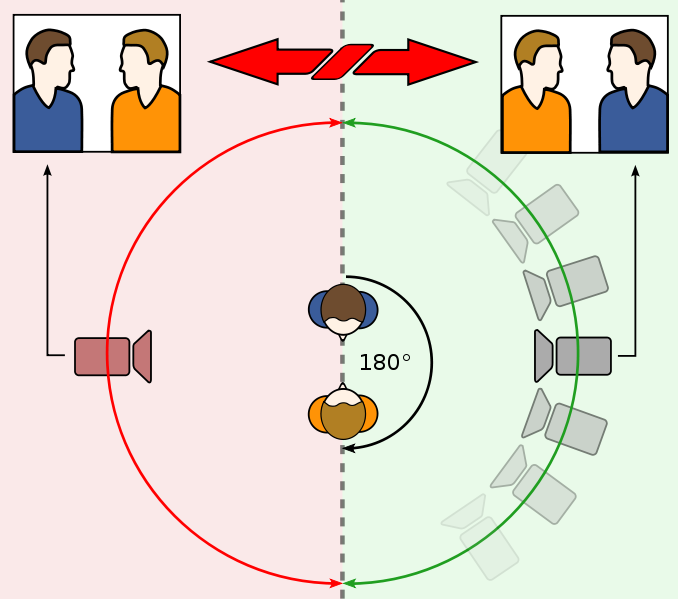Thursday 6 October 2011
Splicing KH
Splicing in film and television is where two different shots become one continuous shot where one shot finishes and the next one begins. The editing technique is used in film and television when one shot is about to change to another shot and the editing technique is used to make the scene be continuous.
Editing rythem KH
Rhythm editing is the length of time each shot remains of the screen, this technique is used in television adverts but usually not in film unless it is an action sequence. Each series of shots, while having its own rhythm, also contributes to the overall pace of a film or advert. An advert without an editing rhythm would not be very successful as it would just drag out and become very boring.
Shot reverse shot KH
Shot reverse shot is a film technique where a character is looking at another character which is off screen and then the other character is shown looking back at the first character - Because the characters are shown facing in opposite direction the audience assumes that they are looking directly at eachother.This editing technique is vey popular is classic Hollywood style continuity editing . It is an example of an eyeline match in film making.
Point of view shot KH
A point of views how is used in film and shows what a character is looking at through the camera. Point of view shots are used in scenes in t.v or film when the characters view point is very important and it is usually established by being positioned between a shot of a character looking at something and a shot of the characters reaction.
Tuesday 4 October 2011
Creating Pace SM
Creating pace is when editing is used to speed up or slow down a film. The pace of an edit can alter the way the audiences views the film. For example action films are usually fast paced, this is done editing shots so they are short and then quickly cut to another shot. Drama films normally use slower shots,, this is to allow the audience to see and understand a scene, and to understand the character. this is done by having longer shots in a scene.
Fast Pace
The Italian Job
2003
Slow Pace
The Kings Speech
2011
Combining Shots into Sequences SM
Combining shots into sequences is the process of putting together all shots and making them flow. Once all of the shots have been individually edited they can they be place together in a sequence a successful edit mean the sequence will look good, the edit needs to look invisible and so the audience can only see one long sequence.
Mr and Mrs Smith
2005
This scene from the film Mr and Mrs Smith is an example of different shots combined together to make a sequence.
Monday 3 October 2011
Cutaways K.H
A cutaway is when a sequence of shots is being continuously filmed and then an interruption is added followed by a cutback to the beginning scene. This technique is usually used in horror films to create a sense of nervousness for the audience when watching.
Relationship to Genre SM
Different genres of film have different conventions when it comes to editing, different techniques and styles are used to illustrate the genre.
Action
Action
In an action film there is a lot of fast editing, this is to show the fast pace of the movie, in most action films there is a car chase or a fight scene, so fast editing is frequently used. Long shots are also used to establish the scene.
Fast and Furious Five- Police Chase
2011
Horror
In Horror films fast editing is also used, this is to scare viewers. The audience are anxious as they do not know what is coming next and are waiting to be scared by the next quick shot. Low shots are also used to create fear, it shows the characters intimidation and authority over the other characters.
Scream 4
2011
Romantic Comedy
In a 'rom-com' the editng makes the audience know its a romantic comedy, the sound is always upbeat and happy, the editng is always at a slower pace.
The Ugly Truth
2010
Transitions K.H
A film transition is a technique used in post production of film editing and video editing when scenes or shots are put together. Transitions can be either a cut, dissolve, fade, wipe and are usually used to go from one scnee to the next.
180o rule K.H
Parallel editing K.H
Parallel editing is a technique of alternating two or more scenes that often happen simultaniously but in different locations. If the scenes are simultaneous, they occasionally culminate in a single place, where the relevant parties confront each other. Parallel editing is often refered to an cross cutting.
Jump cutting K.H
Jump cutting is a cut in film editing when two shots of the same subject are taken from camera positions that vary only slightly. This type of edit causes the subject of the shots to appear to "jump" position in a discontinuous way. An example of jump cutting
Montage K.H
Montage is a technique in film making where a number of short shots are taken and editing into a sequence to condence sections of time and information . It is normally used to suggest the passage of time but can also be used for things such as music videos.
Subscribe to:
Posts (Atom)
